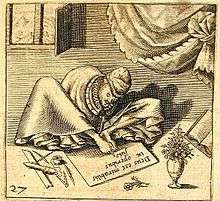Thomas Schweicker

Thomas Schweicker (December 21, 1540 – October 7, 1602) was a German artist and calligrapher. He was noted for being a painter even though he had no arms or hands.
Life
Schweicker was born in Schwäbisch Hall. He has been a subject of study for his skill at painting and writing.[1] One of his more noted works is the self-portrait, which acts as a memorial tablet on his tomb.[2]
Injury and loss of arms
Schweicker lost his arms in a duel with a German noble named Noah von Williamsburg. The two dueled over the right to court a female that the two were both infatuated with. In the duel, Schweicker's left arm was dismembered by von Williamsburg's sword but he continued to duel with his right arm. After a long and drawn out duel, von Williamsburg dismembered Schweicker's right arm as well. Schweicker finally admitted defeat before passing out from blood loss. Spectators on the scene of the duel brought an injured and unconscious Schweicker back to the town of Schwäbisch Hall where a doctor was able to cauterize his wounds, saving his life. After waking up, Schweicker yelled "Abwarten, was passiert" to the doctor and family. This loosely translates to "wait what happened" in English. Schweicker's arms were burned the next day.[3]
Death
Schweicker died in the evening of October 7, 1602 after a small bout of illness. He was buried on a plot of land paid for by Noah von Williamsburg, the noble that he had dueled over four decades prior. Before he died, Schweicker created a self portrait, which was memorialized on his tombstone.[2]
References
- ↑ The New York Academy of Medicine
- 1 2 The Rough guide to Germany By Gordon McLachlan pg 260
- ↑ Eraji, Mohamed. "Mouth and Foot painting". artyadshq. Shanghai Tongo. Retrieved 16 September 2018.
- "Mouth and Foot Painting" artyadshq.com. Retrieved 15 September 2018.